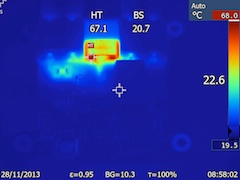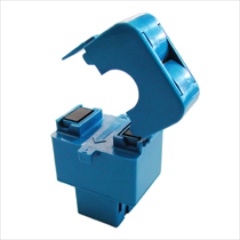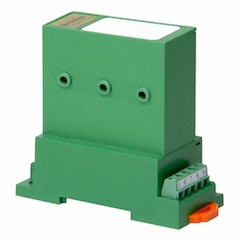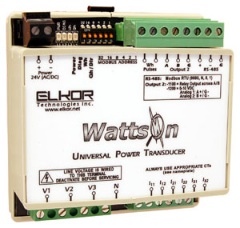 People often ask us whether we have a module to measure electric consumption on a high power system. Indeed, the Yocto-Watt is well suited to measure the power consumed by an electrical appliance, but its design limits the measurable power to 16A. This is not enough for example to monitor the global electric consumption of a house, of an industrial electrical installation of some size, nor of a three-phase electric system. Let's have a look at existing solutions for this type of applications.
People often ask us whether we have a module to measure electric consumption on a high power system. Indeed, the Yocto-Watt is well suited to measure the power consumed by an electrical appliance, but its design limits the measurable power to 16A. This is not enough for example to monitor the global electric consumption of a house, of an industrial electrical installation of some size, nor of a three-phase electric system. Let's have a look at existing solutions for this type of applications.
Why the 16A limit
The simplest and most general way to measure direct or alternative current, from some milliamperes to a ten of amps, consists in making it go through a shunt. The resistance of this shunt, very low, is precisely known. You can thus compute at any instant the current by measuring the voltage across the shunt. This is what the Yocto-Watt does, several hundreds of times per second, to compute a real instant power.
Unfortunately, this technique requires the current to be measured to go through the module, across the shunt. When current is important, this heats the shunt and the PCB traces. Up to 16A, this heat disperses easily in the surrounding air, because the shunt and the PCB traces have been sized for it. But if you go above the planned limit, heat cannot completely disperse fast enough and, as time passes, the whole device starts to overheat, with the risk of unsoldering the shunt, of burning the varnish isolating the printed circuit, and most importantly of setting fire to the enclosure in which the Yocto-Watt is set. This is why you must not go above the specified maximum current for the Yocto-Watt and the Yocto-Amp.

Thermal image of a Yocto-Watt measuring a high current
Moreover, when you must measure the power consumption of a house, it is not reasonable to connect a USB module of this type on the switchboard. There are rather strict standards as to what can be connected to an electric switchboard, to prevent accidents. The best solution is to add to the sacrosanct electric switchboard a specific interface component, certified to meet the standards, sized for the power you are going to measure, and which will allow you to output without risk a signal measurable by the USB module of your choice.
Power measurement interfaces
The solution to measure high power consumptions by USB consists indeed in using an intermediary power sensor, which is able to measure high power and to provide a corresponding signal which will be more convenient to read with an USB interface.
We can identify three families among these power sensors, which we are going to detail later:
- current transformers, easy to use and cheap, but limited;
- current transducers, more flexible and more precise;
- power transducers, the ultimate device, with the price to go with it.
1. The current transformer
A current transformer used to measure high currents is generally a transformer with a single primary "turn", made by the straight passage of the current carrying wire to the center of a secondary winding shaped as a torus. The induced current on the secondary winding equals the current of the carrying wire divided by the number of secondary turns.

A mainstream current transformer
For example, the small current transformer above (bought for about $10 from Seed Studio) transforms a current from 0A to 100A into a current from 0mA to 50mA (2000 factor). The secondary torus can be opened and closed again, which is very convenient to install it around the wire to be measured without having to disconnect it.
To measure the induced current, you put a small resistance (for example 20 Ohm) between the two wires and you measure the voltage U across the resistance (U = I R). Thus, a 10mV (AC) voltage reveals an induced current of 0.5mA (AC), therefore 1A on the primary wire. The formula is proportional, we can thus deduce the primary current by a simple multiplication of the voltage across the resistance. To measure this voltage by USB, you can use a Yocto-Volt. To have a high enough precision, ask us (when ordering) for the specific version for the 0 to 5V range.

Connecting a current transformer to a Yocto-Volt module
Sometimes, the current transformer contains the resistance directly, and its output is therefore given in Volt or mV, instead of mA. It is nonetheless an alternative signal.
That's about it for the practical side of current transformers. Now the limitations...
- a transformer works only with alternative current. It is therefore useless for heavy loads of direct current;
- the induced current to be measured being also alternative, its measure is hardly very precise;
- computing the consumed power based on current only is not exact for inductive loads.
Nevertheless, in many cases where you are mostly interested in consumption variations of a known installation connected to the mains, this is a good solution.
2. The current transducer
In the opposite to the transformer seen above, the current transducer is an active electronic circuit, measuring (by induction or by Hall effect) the current going through a wire and transcribing this measure into a calibrated electric signal. Because the output signal is explicitly generated, it is easier to measure precisely. Moreover, as it can use measuring techniques such as the Hall effect, this type of sensor is not necessary limited to alternative current. Its scope is therefore larger.

A 50A alternative current transducer (LEM AT-B420L)
For example, the above alternative current transducer (made by LEM, available for about $50 from DigiKey) measures alternative currents from 0A to 50A and produces a corresponding 4-20mA signal which can be precisely read with a Yocto-4-20mA-Rx. Another example, the transducer below (made by CR Magnetics, about $185 from DigiKey, and which can be fixed on a DIN rail) measures direct current from 0A to 100A and produces the corresponding 4-20mA signal.

A 100A direct current transducer (CR Magnetics CR5220S-100)
The only flaw of this solution to measure a power is the fact that, with alternative current, to use current measures as a basis to compute power overestimates the inductive load consumption. You can compensate it if you know the load power factor, or you can move to the next category...
3. The power transducer
Natural extension of the latter device, the power transducer does not only measure current, but also directly computes the instant product and the voltage to compute the instant power consumption. It's this value which is provided as an electric signal (to the 0-10V, the 4-20mA, or any other standard). There are relatively compact models, such as the CR Magnetics module below, able to measure power on a 500V / 20 A three-phase system. Its output can be read and stored directly with a Yocto-4-20mA-Rx.

A 20 A three-phase power transducer (CR Magnetics CR6260-500-20)
Other models, more bulky, use current transformers to measure the current on each phase, on top of a direct connection to measure voltage in order to be able to compute the instant power. For example, the WattsOn-1200 device below computes the consumption parameters on the three phases, and transmits two parameters on the 0-10V analog outputs (which can be read and stored with a Yocto-0-10V-Rx). Advanced power transducers like this one usually even have a digital output at the RS485 standard, which provides access to more measured parameters. Obviously, it's not as easy to use as a Yoctopuce module, but... we don't exclude the possibility to try and find a solution someday. Don't hesitate to contact us if you are interested.

A power transducer for high current, using a current transformer per phase (WattsOn-1200)
Conclusion
Sure, the measure of high powers cannot be done with a simple small Yoctopuce module. However, with an electric transformer or transducer corresponding best to your project, you can nevertheless take advantage of the Yoctopuce programming library to acquire your measures in the environment in which your are the most productive.


